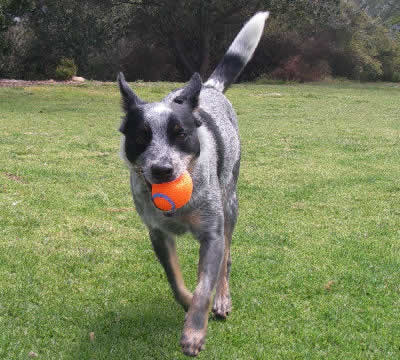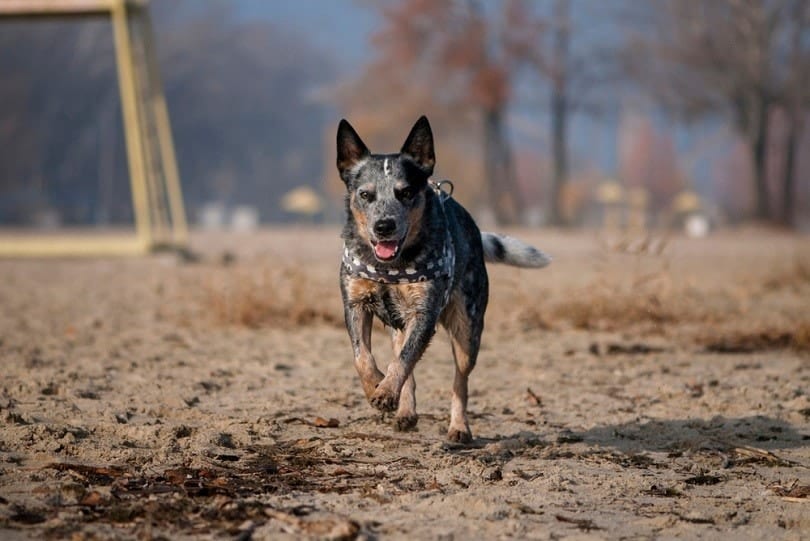
The Australian Cattle Dog is an especially energetic, loyal dog suited for cattle herding and other organized activities. They have a wild appearance, but can make great friends.
The Australian Cattle Dog is a hearty breed with a lot of power packed into its small frame. It is a high energy dog that can keep up with a high energy owner. This is an extremely loyal and protective dog that is wary with strangers, but relaxed and trusting with people it is familiar with. This dog is alert and intelligent, suiting it well for its traditional job of herding, or more modern activities, such as participating in agility trials or playing Flyball.
- Kingdom: Animalia
- Phylum: Chordata
- Class: Mammalia
- Order: Carnivora
- Family: Canidae
- Genus: Canis
- Species: lupus familiaris
Common Name(s)
Australian Cattle Dog, Blue Heeler, Blue Cattle Dog, Heeler, Queensland Heeler, Red Heeler
Breed Type
This breed is a member of the herding dogs. These dogs were bred for herding cattle or sheep, which explains many of their characteristics. They are extremely active, intelligent, and driven to work. If not provided with an organized activity, such as herding trials or Flyball, these dogs are likely to find something less desirable to do, such as digging up gardens or chewing on shoes. Herding dogs are still currently used to herd livestock, but they can also be great pets for active owners with the time and energy to meet their needs.
Background
The Australian Cattle Dog was developed in Australia by cattle ranchers to control the movement of cattle. This compact dog is agile enough to herd these large animals by nipping at their heels, and quickly dodging their hooves. It was also bred for its endurance to travel long distances. This breed is a direct descendent of the Hall’s Heeler, which is a cross of the Dingo (Australia’s wild dog) and the smooth-coated Scottish Collie. In the 1860’s, the Hall’s Heeler was mixed with the Australian Kelpie and Dalmatian to make the Australian Cattle Dog.
Description
The Australian Cattle Dog is small to medium-sized. Its height is 17 to 20 inches, while its weight is 33 to 55 pounds, making it a compact, muscular dog. Females are slightly smaller than males. The head is broad and medium-length, with a tapering muzzle. The jaw is powerful with large teeth. The eyes are almond-shaped and brown, while the nose is large and black. The ears are medium-sized, and naturally stand straight up, and the tail is long. This breed has a medium-length coat with a dense undercoat and smooth, hard outer coat. The coat colors include blue mottled or speckled, with or without black, blue, or tan markings, and red speckled, with or without darker red markings. They have an average life-span of 12-15 years.
Care and Feeding
This breed has no special dietary needs. It should simply be fed a well-balanced canine diet. The only grooming it requires is an occasional brushing.
Australian Cattle Dogs need regular checkups. Vaccinations are due as follows:
- 6-8 weeks: Distemper, Leptospirosis, Hepatitis, Parainfluenza, Parvo, and Corona virus (DHLPPC)
- 10-12 weeks: Second DHLPPC
- 14-16 weeks: Third DHLPPC and rabies
- Annually: DHLPPC and rabies booster
Housing Your Dog
This breed needs plenty of room to roam and exercise. It prefers an open area in a rural or suburban context, but can adapt to a large yard in the city. This breed is not appropriate for an apartment.
Social Behaviors
The Australian Cattle Dog is an independent breed that needs no canine companions. In fact, it may show aggression toward other dogs. It is friendly with people it knows, but becomes most attached and obedient with one person. Many Australian Cattle Dogs love spending time with their owners, following them everywhere, including the kitchen, bedroom, and bathroom. It is extremely protective, which makes it a good breed for children, though the children may not think so. It rarely becomes aggressive, but is likely to “herd” children by nipping at their hands and feet, which can be frightening to a small child.
Handling and Training
This breed needs firm training and socialization. Since it was bred to be fearless in the face of large animals, physical reprimands are not very effective. However these dogs respond well to positive reinforcement (giving treats or affection for responding correctly).
Activities
This breed loves exercise and structured activities. It needs regular opportunities to exercise its muscles and brain. Some suitable activities include agility trials, herding trials, Flyball, Frisbee, and fetch. They should also be provided with appropriate chewing toys to prevent them from chewing everything else.
Breeding/Reproduction
This breed is born white with whatever color patches that will be present in the final coat. Average litter size is 4-8 puppies..
Common Health Problems
Australian Cattle Dogs are susceptible to deafness, hip dysplasia, and progressive retinal atrophy. Some early signs of deafness in dogs include biting harder than their siblings, since they cannot hear their yelps, and waking up late for feeding time. Some veterinarians are not supportive of deaf dogs, so it is important to find one who is. Hip displasia, caused by looseness in the hip joint, can cause discomfort after exercise, an altered gait, and even an inability to walk. A veterinarian can diagnose and prescribe treatment for this disease, which may include weight management, exercise, massage, supplements, and surgery.
Progressive retinal atrophy causes night blindness first, and then day blindness. There is no treatment for this disease, but many dogs adapt well to blindness, with few signs of the ailment, as long as they are in a familiar setting.
Availability
Australian Cattle Dog breeders can be found on the internet or locally. Prices range from approximately $150 for an adult, $300-$750 for a puppy of pet quality and $1200+ for a puppy of show or breeding quality.
References
Peter Larkin, The Ultimate Encyclopedia of Dogs (Dog Breeds & Dog Care) ,Lorenz Books, 2003
Kristin Mehus-Roe, The Original Dog Bible: The Definitive Source to All Things Dog, BowTie Press, 2005
Walter R. Fletcher, Dogs of the World, Bantam Doubleday Dell Publishing Group, 1983
Pet Education, www.peteducation.com (2007). Foster & Smith Inc. Author: Ruth Bratcher
Featured Image Credit: Iryna Dobrovynska, Shutterstock
